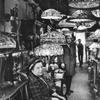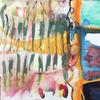Festina lente: Conserving Antiquity opens at the Davis Museum at Wellesley College on January 30
- WELLESLEY, Massachusetts
- /
- January 23, 2013

WELLESLEY, Mass. – Festina lente: Conserving Antiquity, an unconventional behind-the-scenes approach to viewing the Greek and Roman art in the Davis permanent collections, opens at the Davis Museum on January 30. Focused on collecting, conservation, and stewardship, the exhibition invites new research and scholarship regarding a range of objects —some, deeply beloved long-time fixtures in the Davis galleries, and others, hidden from view for decades. On view through July 7 in the Marjorie and Gerald Bronfman Gallery, the exhibition is free and open to the general public.
Infused by a spirit of inquiry and wonder, the exhibition and related programs (featuring scholars, curators, and conservators) illuminate the challenges facing museum antiquities collections, including questions of attribution, provenance, and authenticity; the science of investigation; changing strategies and shifting aesthetics in restoration; the function of and framework for managing fragmentary objects; the search for traces in abraded and eroded surfaces; and trends in collecting over time.
According to Lisa Fischman, Ruth Gordon Shapiro ’37 Director and curator of the exhibition, “The classical adage, Festina lente, greatly favored by the first Roman emperor, Augustus, pertains to the collecting and conservation of antiquities—but also to the larger project of museums overall. To “make haste slowly,” is to balance urgency and diligence, risk and caution. This perfectly describes the accumulation of knowledge on any subject, and is particularly apt in regard to the focus on collecting, art history and archaeology, scientific research and conservation treatment that distinguishes this project.”
While referencing “open storage,” the exhibition is designed to encourage study in the galleries as well as to present research culled from the Museum’s object files and new scholarship as it develops. Featuring vases and vessels of all sorts and designs, relief portraits and standing figures, mosaics, coins and jewelry, human and animal forms, the scope of the collection reveals tremendous vitality of form and function rendered in clay, terracotta, metal, and stone. With works from the third millennium B.C.E through the early fourth century C.E., the exhibition will allow viewers to see the evolution of style over time, as well as a regional variety in art from the ancient world.
Among the rarely seen items that will be on view is a marble, limestone and glass tesserae mosaic panel from the Greek city of Antioch. According to Kimberly Cassibry, Assistant Professor of Ancient Art, “the ‘Rinceaux and Meander’ mosaic was created by one of the very best workshops of antiquity. The mosaic once formed part of an elaborate dining room floor, which was divided up among five different museums after excavation. The adjacent section is now in the Louvre! Because of its size and weight, the "Rinceaux" panel has been in the Davis' deep storage for years. Festina lente offers the opportunity I've been waiting for to bring it back into the galleries. Visitors will enjoy the beauty of its intricate floral design and will also be interested in the story its excavation tells about Wellesley's place in the history of archaeology."
"It’s very exciting that so many of the Greek and Roman artifacts will be on display this spring in a setting where we can consider what kind of conservation and research they deserve,” added Bryan Burns, Professor of Classical Studies. “It's also great to learn the history of some of these items, such as a group of small objects that was donated by an alumna (Harriet W. Allen '24) whose grandfather was a friend of the famous archaeologist Heinrich Schliemann. She also donated two books – one inscribed by Schliemann himself in Greek – which have been in the stacks of the Art Library, used by students for decades. I have to wonder if any of those students reading about the excavations at Troy ever noticed that this book was actually signed by the author!"
For a complete list of programs related to the exhibition, please visit www.davismuseum.wellesley.edu.
Festina lente and related programs have been generously supported by Wellesley College Friends of Art.
DAVIS MUSEUM GENERAL INFORMATION
Location: Wellesley College, 106 Central St., Wellesley, Mass.
Museum Hours: Tuesday–Saturday, 11:00 am–5:00 pm, Wednesday until 8:00 pm, and Sunday, noon–4:00 pm. Closed Mondays, holidays, and Wellesley College recesses.
Admission is free and open to the public.
Telephone: 781-283-2051
Website: www.davismuseum.wellesley.edu
Parking: Free and available in the lot behind the museum. Additional parking is available in the Davis Parking Facility.
Tours: Led by student tour guides and curators. Free. Call 781-283-3382
Accessible: The Davis, Collins Café and Collins Cinema are wheelchair accessible and wheelchairs are available for use in the Museum without charge. Special needs may be accommodated by contacting Director of Disability Services Jim Wice at 781-283-2434 or jwice@wellesley.edu.
ABOUT THE DAVIS MUSEUM
One of the oldest and most acclaimed academic fine arts museums in the United States, the Davis Museum is a vital force in the intellectual, pedagogical and social life of Wellesley College. It seeks to create an environment that encourages visual literacy, inspires new ideas, and fosters involvement with the arts both within the College and the larger community.
ABOUT WELLESLEY COLLEGE & THE ARTS
The Wellesley College arts curriculum and the highly acclaimed Davis Museum and Cultural Center are integral components of the College’s liberal arts education. Departments and programs from across the campus enliven the community with world-class programming– classical and popular music, visual arts, theatre, dance, author readings, symposia, and lectures by some of today’s leading artists and creative thinkers–most of which are free and open to the public.
Located just 12 miles from Boston and accessible by public transit, Wellesley College’s idyllic surroundings provide a nearby retreat for the senses and inspiration that lasts well after a visit.
Since 1875, Wellesley College has been a leader in providing an excellent liberal arts education for women who will make a difference in the world. Its 500-acre campus near Boston is home to 2,400 undergraduate students from all 50 states and 75 countries.
Contact:
Nina J BergerDavis Museum at Wellesley College
781-283-2034
nberger@wellesley.edu
106 Central Street
Wellesley, Massachusetts
ninajberger@hotmail.com
781.283.2051
http://www.davismuseum.wellesley.edu
About Davis Museum and Cultural Center
One of the oldest and most acclaimed academic fine arts museums in the United States, the Davis Museum is a vital force in the intellectual, pedagogical and social life of Wellesley College. It seeks to create an environment that encourages visual literacy, inspires new ideas, and fosters involvement with the arts both within the College and the larger community.

270x400_c.jpg)

10270x400_c.jpg)
__A270x400_c.jpg)
270x400_c.jpg)













